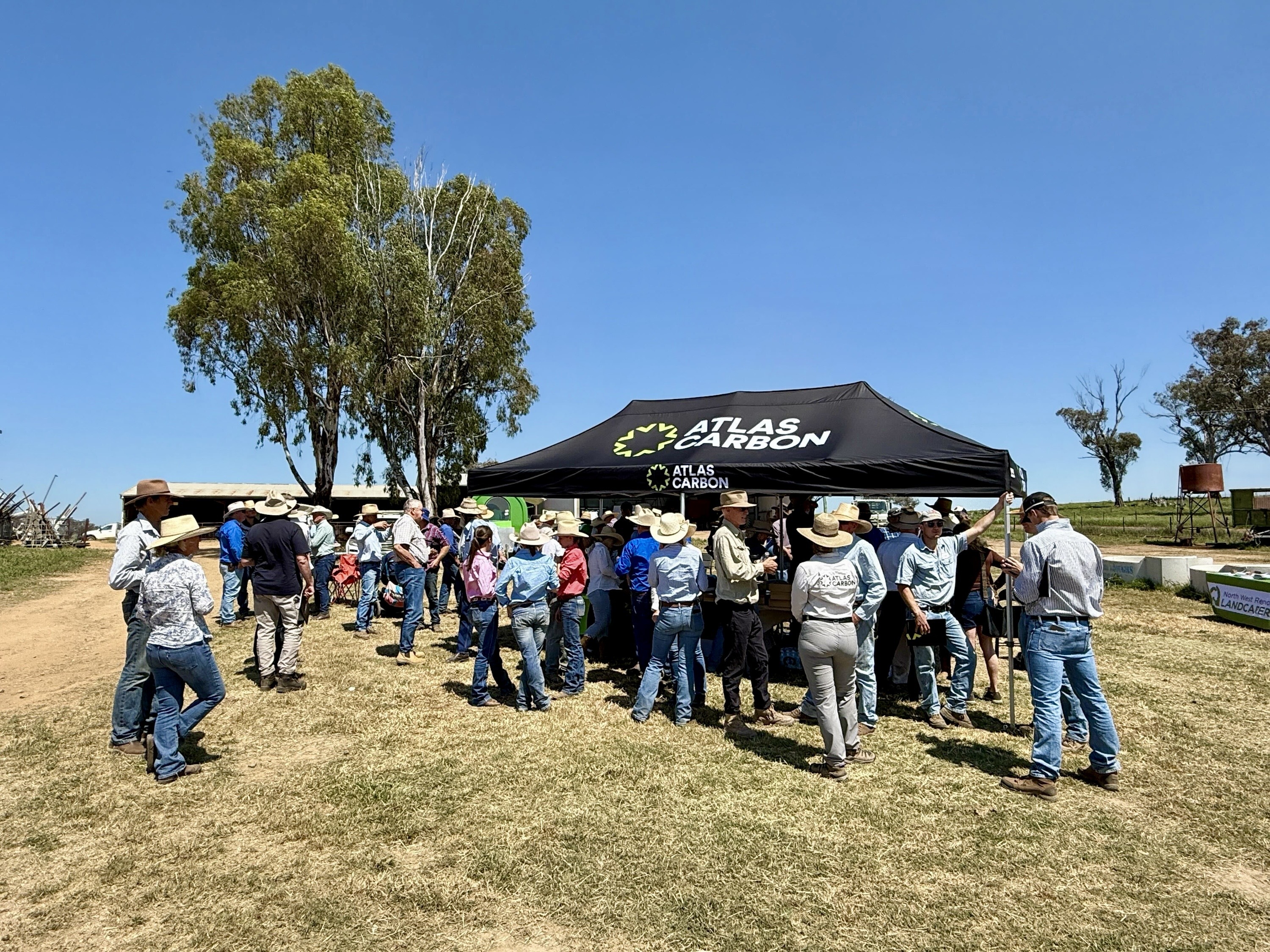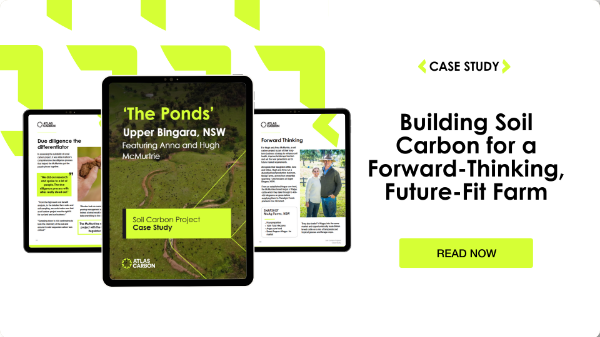Meet The Hosts: Hugh and Anna McMurtrie
Hugh and Anna run McAg, incorporating 4 beef cattle properties spanning over 7,000 hectares in Upper Bingara, NSW. From an Angus breeding herd, they produce Angus x Wagyu cattle for grass finishing and also trade F1 Wagyu into premium markets. Their focus on increasing grass production per hectare has led to the adoption of practices that enhance soil health, including rotational grazing, pasture improvement and strategic forage cropping. McAg’s soil carbon project was registered with the Clean Energy Regulator in 2025.
Event Recap
In September, we had the pleasure of hosting a field day at 'The Ponds,' one of Hugh and Anna McMurtrie’s properties near Upper Bingara, NSW. The event showcased practical approaches to building soil carbon on a working beef cattle property.
The McMurtries’ decision to register a soil carbon project earlier this year was grounded in a long-term vision to improve soil health, enhance landscape function, and prepare for emerging market opportunities and requirements.
The day drew a crowd of around 80, including producers, consultants, and industry professionals. What followed was a valuable day of grazing-focused learning and networking.
The field day at ’The Ponds’ was supported by the NSW Government’s High Impact Partnerships program with Atlas Carbon and Wilmot Cattle Company. This program aims to deliver emissions reduction and promote sustainable land management practices in agriculture to support NSW’s net-zero target.
Conversation with the Producer

The day began with an introduction from the youngest generation of the McAg team. Millie, Zara and Chloe McMurtrie who shared the story of their family’s grazing business, first established by their grandparents, David and Dimity McMurtrie (also in attendance).
They reflected on how the enterprise has evolved, and shared the journey that led to them registering a soil carbon project with Atlas Carbon.
From there, Atlas Carbon’s Col Feilen challenged the group to rethink how we measure and value production within a landscape:
"Don’t just focus on improving ground cover and pasture utilisation, think volumetrically. How much of the cubic metre of soil beneath each square metre of pasture is actually working for you? And how are you growing and managing the below-ground biomass, the living roots, to drive the above-ground productivity that your enterprise depends on?”
Bart Davidson, Atlas Carbon’s Chief Grazing Officer, built on this point throughout the day:
“A soil carbon project is first and foremost a grazing project….. it’s all about production”
Across the McAg properties, the groundwork has been done - identifying suitable soils, assessing scale, and confirming the project’s economic viability. The focus now is on “the doing”: implementing the grazing management, infrastructure, and monitoring required to build carbon and drive production.
Early indicators are impressive. The McMurtries’ dedication and commitment to driving change on their properties, via investment in water, fencing, and mob movement, has already delivered an estimated 20% uplift in production.
The Paddock Walk
After lunch, we headed out on a paddock tour that brought these discussions to life.
Our first stop was a 50-hectare paddock stocked with 1800 head of cattle. An impressive sight that only a few in the group had witnessed at this scale previously.
.png)
The team discussed the benefits of this high-density grazing approach, including:
- Reduced selective grazing,
- Improved nutrient distribution and cycling,
- More even ground cover,
- Keeping pasture in the active growth phase.
In the next paddock, Atlas Carbon’s Rafe Ritchie, soil sampling and grazing specialist, demonstrated the process of taking a 1.2 metre soil core sample. As the sample was examined, Rafe unpacked the narrative of the morning’s discussions: what we’re seeing below ground is directly reflected in the above-ground biomass we’re standing in.
It’s clear McAg is starting to utilise The Ponds volumetrically, driving soil, pasture and therefore cattle potential.
Atlas Carbon CEO, Ashley Silver, added context on the technical backbone of a successful soil carbon project, driving home the importance of accuracy at the initial stage:
“Even when you’ve identified the potential of a project through sound due diligence, it’s critical you have the right expertise behind you. Baseline sampling and setup are done once at the start of a 25-year project; they have to be done right.”
From there, we visited a multi-species crop paddock transitioning to subtropicals, where Hugh reflected:
“This paddock’s in transition — it owes me a bit — but it’s there for a reason and it’s doing a job.”
A few paddocks over, that “job” was in full display. Paddock number four was a fully developed subtropical pasture, introduced as the highest long-term yielding paddock on the property.
As Bart and Hugh discussed, maintaining a consistent plane of nutrition across a variable landscape is one of the biggest challenges in grazing management.
“We all have a few paddocks that are just ‘wow’ - they’re a 9 or a 10, and we do everything we can to keep them there”
(and we sure saw some of these at the Ponds).
“But we also have those paddocks that we’d rate a 4 or 5 for the same livestock. Real improvement comes from lifting the middle — having more country sitting at a 7 or 8 to reduce those swings in quality.”
Continuity in feed quality is key!
A useful exercise on your own property is to rate each paddock from 1 to 10 and ask yourself: How much variation is there in feed quality across the paddocks each stock class tends to graze?
More Details on McAg’s Soil Carbon Project
As part of their soil carbon project registration, the McMurtries identified several management practices to focus on in their soil carbon project. These include:
Balancing stocking rate to carrying capacity.
- McAg utilises MaiaGrazing to understand paddock performance relative to rainfall, grazing yields, rest and recovery periods to optimise individual grazes and balance overall stocking rate to carrying capacity
Paddock Subdivision
- Water and wire infrastructure has enabled greater grazing density, improving pasture utilisation and recovery.
Addressing nutrient constraints
- Feedlot manure, gypsum, rock phosphate and other trace elements are being used to remediate soil nutrient constraints.
Perennial subtropical pastures
- The continued roll-out of Perennial subtropical pastures is a core part of the focus. The existing subtropical paddocks remain consistently high yielding performers for McAg
Slowing the flow
- Rehydrating the landscape by helping water to spread more evenly through the property. Natural sequence farming principles have been applied in priority areas identified using LiDAR scanning via Agronomeye
Ultimately, all these practices are about producing the most grass we can per hectare, and then using livestock to cycle that organic matter and carbon into the soil” - Hugh McMurtrie

Reflections
The field day officially wrapped up at 3pm, though conversations and networking carried on well into the evening. It was a fitting end to a day filled with open discussion, shared learning, and practical insights.
A huge thanks must go to the McMurtrie family for generously opening their property and sharing their soil carbon journey with the group.
The Ponds Field Day reinforced a central message. Soil carbon projects are not just about carbon. They are about building productive, resilient grazing systems that strengthen both the land and the business.
.png)



.png)
